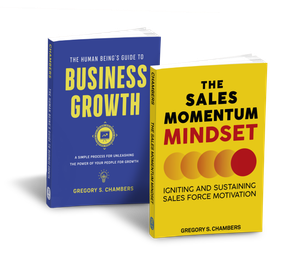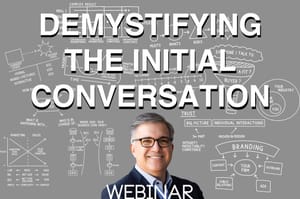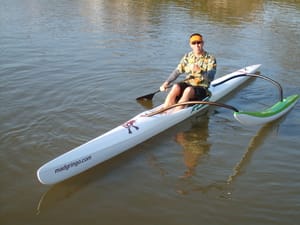Right FIT Newsletter #137: Language, Right decisions, Sunglasses

GREG'S RIGHT FIT NEWSLETTER #137
Quick notes to help you get more sales and marketing done in less time. . . next week.
In this issue:
- Techniques for FIT
- Being Human
- Random Stuff
Techniques for FIT
- Be prepared. When I hear, "I hate scripts," I remind them that Streep, DiCaprio, and others use scripts. Say, "I hate the poor delivery of scripts" and get better at it. Prepare for success.
- Match your language to your customer's stage of the sales cycle. Early stage begins with "How do I?" late stage is "best price for. . "
- Using technology to help you do more with less effort takes an initial investment of time, just like hiring an assistant takes an investment of time in order for them to be effective.
- If the objection is money or time required, think of those as priorities. If the objection is they have no need, think of that as your job to understand or demonstrate. However, if you can't develop trust, it doesn't matter what the objection is, you're sunk.
Being Human - The right decision.
------------------------------------------------------------
Helping Clients Succeed
In sales and client development we are, at the purest level, working on one thing: helping our clients make a good decision. I used to say, “making the right decision,” but over time I’ve realized that there are multiple paths to success so a good decision is what’s best for everyone. Good decisions start with knowing where we are today, where we want to be tomorrow, and understanding the path to get there will be messy.
When surveying clients about what information we need from prospects to help them make a good decision, I get answers like “who will decide” and “budget” which are all good items that will help frame the decision, but if we’re going to really get good at helping clients make good decisions, start with three key definitions.

The first are the “must-haves.” The client’s non- negotiables. They are important because any right or good decision is going to have them included or the client isn’t getting what they want. These must-haves come from the client and it’s our job to be aware of them regardless of whether or not they are on our list of must-haves. For example, if a client is looking for an operations manager, they can express that must-have as “candidate must be able to get to the plant every day and in case of emergency.” Even if I feel a nationwide search would be best, I am going to better serve my client by exhausting a local search first.
The second are the “nice-to-haves.” These items aren’t critical to the success of the decision, but will sound a lot like the must-haves. How do you differentiate? Try taking it away. “If we found someone who was perfect, but lived in another state and promised to be at the plant Monday through Friday, would that work?” If you can take it away and the client feels like they can still reach their goal, it’s a nice-to-have versus a must-have.
Those are obvious to most of you and you do it naturally. The only trap to watch for is assumptions. To help your clients make good decisions, you need to hear them say it. No guessing.
The third definition is addressing risk. If you know their must-haves and have a list of nice-to-haves, the next step is to address risk. What future events or circumstances could derail this decision?
Going back to our fictional plant manager, let’s step ahead and assume we find a local candidate that fits the must-haves and has a few of the nice-to-haves. What could derail their success? What if they perform below expectations? What if they don’t integrate with the management? What if they get recruited away?
The risk questions seem endless, but they serve a dual purpose. They reaffirm the must-haves vs nice-to-haves, and they help make a good decision better because the client can think about contingencies and preventative actions and put the right plans in place.
Know the clients must-haves, their nice-to-haves, and help them address risk adds up to a good decision.
Random Stuff
It's a little hazy
I have been dealing with a low level sinus infection (self-diagnosed) for about two weeks now. One of the side effects is I wake up with giant dark circles under my eyes. I have a big meeting coming up, so I take to the internet to get relief from my death-warmed-over look.
Thirty minutes later I'm on the couch with cooled, black tea bags on my eyes, legs elevated and timer set for twenty minutes. I admit that it feels great, but I don't see much of a difference in the mirror.
My daughter catches this and suggests I use the tiny marble roller thing that just arrived in the mail. I guess if you use the rollers to push out the bad stuff accumulating below your eyes, "up into your lymph nodes, then from the forehead down to your neck nodes – but don't stop there – get all that bad stuff our of your neck into the body." I try it but get a little confused, and honestly, pressing on my nodes or whatever kind of hurts.
I do a little physical activity, drink a little coffee, take a shower, toss in some eye drops to remove the redness, and nothing. No change. I look like a basset hound.
I pull out the phone and pull up my client's phone number. "Good morning! Can we change our meeting to Starbucks? It's nice outside."
I wait for the dots to disappear and the response comes, "Sure."
That settles it. Sunglasses.
(••)
( ••)>⌐■-■
(⌐■_■)
Booking Calendar
If you need to set up a time to visit, follow this link:
https://calendly.com/chamberspivot/




